
Perennial Plants. First Year Flowering
What Are Perennial Plants?
Perennials are plants that live for 2 years or more. They flower each year usually in spring and summer following a period of dieback and dormancy.
Some plants that are perennial in their native habitat are grown by gardeners as annuals due to the differences in climates and locales.
There are also evergreen perennials such as Bergenia which retain their leaves throughout the year and produce flowers in spring.
Perennial plants have adapted naturally to survive in various temperate zones.
They have also been extensively bred in order to have varieties to suit most conditions.
Some can survive hot and dry, whilst others relish damp, cooler conditions.
Perennials seeds can either be planted in autumn, these will flower the following spring and summer or in the early spring and they will flower the next year in spring or summer.

Perennial Plants First Year Flowering
What I want to talk about today however, are the perennial plants that will flower in the first year from seed grown in early spring. Patience is a requirement for any gardener but I admit to wanting some instant gratification in my garden on occasion.
Why wait for flowers for a year or more? Or why buy garden ready plants when we could be growing our own plants from seed. Growing from seed is highly satisfying and therapeutic and, for the budget conscious, a whole lot cheaper!
For information and tips on how to grow plants from seed please check out my post how-to-grow-seeds-5-easy-steps
My Top 10 Perennial Plants
Agaste

Agaste has tall spires of blue/purple, orange, red or pink long-lasting flowers, and they add autumn interest too. This quick growing and low maintenance perennial attracts bees, butterflies and moths. Leave over autumn and winter before cutting back as this provides shelter and habitat for beneficial insects.
Thrives in full sun or part sun/shade and will tolerate drought in a sheltered sunny border.
Gaura lindheimeri

An abundantly flowering plant, gaura is graceful and floaty, attracting many pollinators to its white, star-shaped flowers.
Easy to grow from seed and it looks wonderful in mixed borders.
They prefer a position in full sun with good drainage. Protect from cold and frost through winter.
Verbena Bonariensis
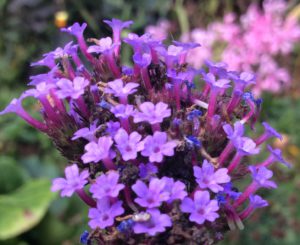
A must have for pollinators. This low maintenance plant is ideal for informal planting schemes.
Tall stems with purple florets through summer to first frosts. The seed heads also add further interest and form.
They require nutrient rich soil and plenty of water in a free draining, sunny position.
Lobelia Cardinal
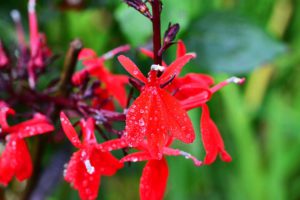
Best grown in a sunny spot with some afternoon shade, they are ideally suited for the border.
The spires of deep red flowers with purple/brown foliage are a great colour contrast, they add depth and interest to your colour scheme in late summer to early autumn. Protect from frost through winter.
Give them nutrient rich, free draining soil.
Salvia patens Blue Angel

A true blue! Happy in the borders or containers. Tubers can be overwintered and re potted in spring.
Regular dead heading will produce more flowers.
Sweet William
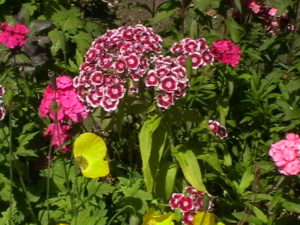
Sweet William offer lots of variety in single or bi-colour options.
Easy to grow in most soil conditions and long-lasting.
They will self-seed easily too providing many more plants.
Great for planting in containers or borders.
Eryngium
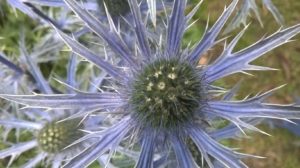
I love these. Their silvery blue or deep blue colours look fantastic in colour-themed planting schemes.
Spiky, prickly and interesting forms add contrast when planted alongside plants with softer foliage.
They are a magnet for Bees and other pollinators.
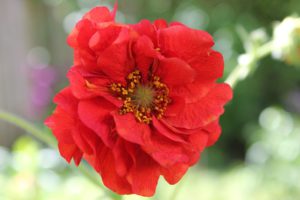
Geum
Bright red or orange flowers on long stems above low foliage.
Easy to grow in most border/soil conditions in a free draining, sunny spot.
Ideal cut flower.
Crowns can be split in subsequent years, providing more plants.
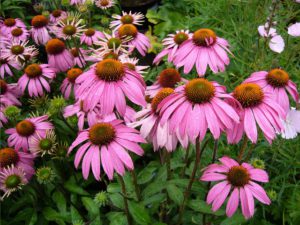
Echinacea.
The bright, long-lasting flowers of Echinacea are a colourful addition to any planting scheme, attracting many pollinators to your garden.
The seed heads also contribute to form and texture in autumn and winter.
Lupine
A firm favourite with gardeners. Lupine come in many lovely colours and are easy to propagate from seed.
They look great in mixed borders, particularly in cottage style gardens.
Protect young plants from slugs and snails.

Tips For Seed Grown Perennial Plants
- Sow 3 seeds to a pot, plant out together, this gives maximum impact in your borders.
- The plants can be split in the following year.
- Some perennial seeds need bottom heat to germinate.
- Others require chilling to germinate. Sow in autumn and leave outside in a cold frame
or put the seeds in a plastic bag with some compost and keep them in a fridge for six weeks prior to planting.
- Always check growing instructions and recommendations on seed packets.
- Check for and remove any slugs found on pots of outdoor seeds.
- Dead head plants regularly to prolong their flowering period.
Sow The Seeds Of Summer
Growing and planting annuals is all well and good, there are many annuals I love and grow every year but after flowering they are discarded. Perennials however will flower year-on-year providing colour, fragrance, interest and will attract plenty of wildlife. So whilst deciding which seeds to grow this year, think about including some perennials too.
Let’s get out there now and grow some plants for this summer and autumn flowering! There are so many plants to choose from and the choice is entirely yours. Select what pleases you and have a go at growing them. I guarantee that you will enjoy doing so. The anticipation of what you will produce and how it will look in your beautiful outdoor space is priceless.
For more ideas on Summer Plants Bulbs Seeds see Summer Flowering Bulbs A colourful addition to summer gardens.
Please share this with friends and family and on social media. If you have any questions or views on this article then pop them in the comments box below, I always reply as soon as possible.
Happy Gardening.

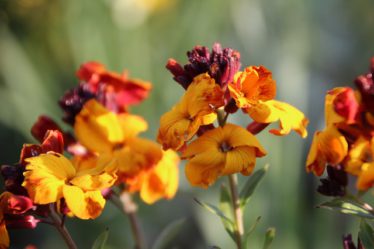
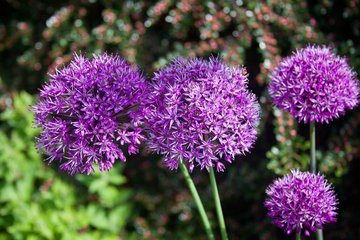


These are some beautiful flowers! I am looking to add some perennial plants to my landscape soon. I think the Echinacea and Lupine look nice. Do you think they would work in Florida? A lot of flowers that grow up north do not grow well here. I will have to look around your website for more plant information, this will be my first time trying to grow flowers.
Hello Anita, lovely to hear about your garden in Florida,
Echinacea are a great choice, they are originally a prairie plant, they grow well in full sun, in fertile, well drained soil. Water well in their first year.
They are drought resistant. I don’t know what zone Florida is, (I am in the UK) but echinacea are fine in heat zones 9 – 1.
Lupins are also good in full sun if given plenty of water, they will self seed as well or you can collect the seeds to grow on in pots.
Hope this helps. Visit my website anytime!
Louise
Waiting for a year or more for a flower to blossom to the beauty that it becomes is really worth it. I know that after making that first plant and envisioning what it would look like in beautifying your environment can make the wait to be rather difficult but waiting that one or two years for it to become really beautiful is just amazing.
These are all amazing flowers and I have not really planted any of them. My favorite is Eryngium. I just like the way it looks and I bet it would look great in my garden.
Hello,
Thank you for your comments
Eryngium are lovely I’m sure they would look great in your garden.
Louise